The Nagasaki Kunchi festival!
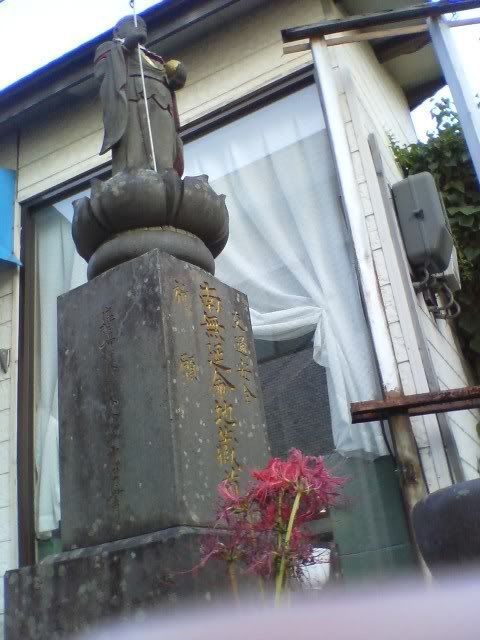
Welps, though I still don't have a proper digital camera, I've been making do with my camera phone. I hadn't been taking a lot of pics (aside from this shot of a statue near my school, with a healthy dose of my finger at the bottom), but this past Sunday (the 7th) I had just the occasion!
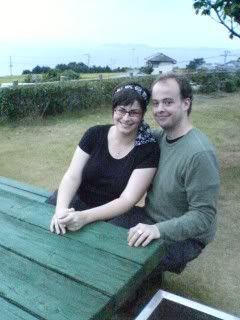
Nagasaki city has an annual festival that is arguably one of the best in Japan. It's called the Okunchi (or Kunchi, I've heard both) festival, and it started hundreds of years ago. Over three (!!) days, the city is just a massive throng of people, all come to see the different floats and performances. Gill, Megan, Alex, and I (the right -> pic was taken at the end of the day) piled into Meg and Gill's leased car and made our way down to Nagasaki city, following the van of Kondo-sensei (a teacher friend of Gill's who generously offered to show us around), where a Chinese ALT named Zhang also rode along.
When we got down to Nagasaki station, there were a bunch of high school students handing english pamphlets that described the festival, I think for a school project. The description of the festival that they wrote is this: "Kunchi comes from the ancient custom of holding a celebration on the ninth day of the ninth month of the lunar calendar, which was considered a lucky day. The ninth day is pronounced "ku nichi", which gradually changed into "kunchi" in Nagasaki. Kunchi came to mean a celebration holiday. Suwa Shrine was built in 1624. Nagsaki Kunch began ten years later, and now has a history of more than 370 years. "
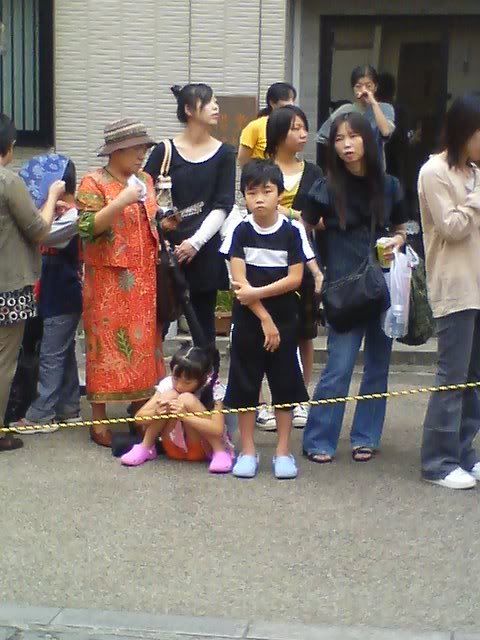 Inside the pamphlet were descriptions of the different things you could expect to see throughout the festival, which included various dances, huge floats pulled or carried by teams of men, and even a dragon dance.
Inside the pamphlet were descriptions of the different things you could expect to see throughout the festival, which included various dances, huge floats pulled or carried by teams of men, and even a dragon dance.Japanese prefectures and cities are completely divided up, and each address comes with information about which 'town' the person lives in, even within a large city. The Kunchi festival is a celebration where a number of large 'towns' or 'machis' (mah-cheese) get together and create 'floats' and performances to represents themselves.
Since we only went for one day, we didn't get to see all the
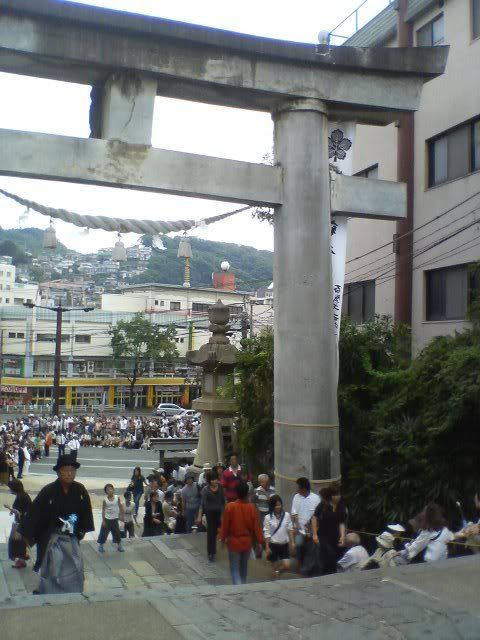 performances, but thanks to Kondo-sensei we did get a Japanese speaker to guide us to a few spots. It was the first time going for him too, so he wasn't exactly a Kunchi veteran, but he could read the maps and was very helpful with taking us to good places. We had to do a bit of standing around and waiting, which was rough since it was such a humid day, but c'est la vie.
performances, but thanks to Kondo-sensei we did get a Japanese speaker to guide us to a few spots. It was the first time going for him too, so he wasn't exactly a Kunchi veteran, but he could read the maps and was very helpful with taking us to good places. We had to do a bit of standing around and waiting, which was rough since it was such a humid day, but c'est la vie.The first place we went was a shrine, where we got to see a procession. The first peop
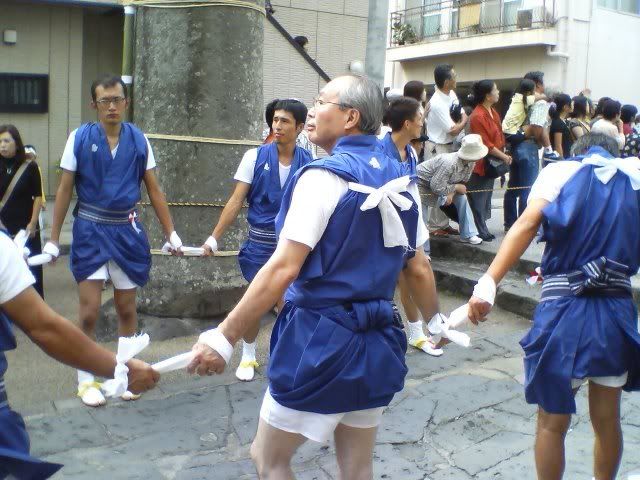 le to come down the many steps towards the street were teams of men dressed in blue, and for a good while they just stopped and stood, occasionally flexing and stretching their legs. After a little while they tied themselves loosely together with white pieces of cloth, and the procession began.
le to come down the many steps towards the street were teams of men dressed in blue, and for a good while they just stopped and stood, occasionally flexing and stretching their legs. After a little while they tied themselves loosely together with white pieces of cloth, and the procession began.A few men in white robes (and veeeery tall hats) went first, followed by a series of lovely shrine maidens. Then came men in green with what Alex called
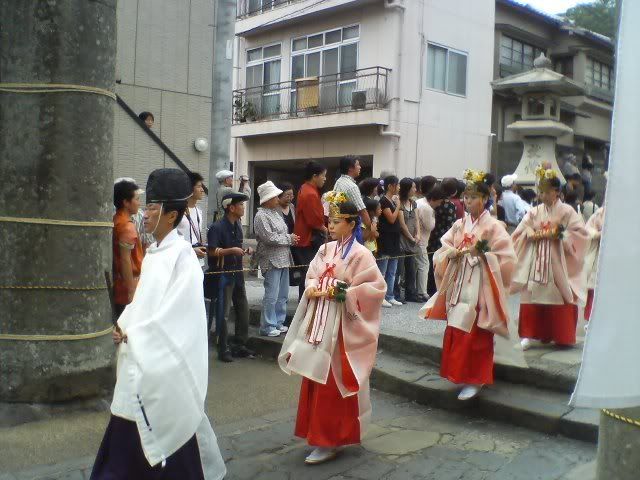 'totally kung-fu' hats, and finally men wearing formal black robes (and bowler hats, in what I'm guessing a throw-back to the popular fashion around the time of the Meiji restoration) finished the procession. I think they might have been company representatives or something, since we saw them ambling around before the official procession began earlier.
'totally kung-fu' hats, and finally men wearing formal black robes (and bowler hats, in what I'm guessing a throw-back to the popular fashion around the time of the Meiji restoration) finished the procession. I think they might have been company representatives or something, since we saw them ambling around before the official procession began earlier.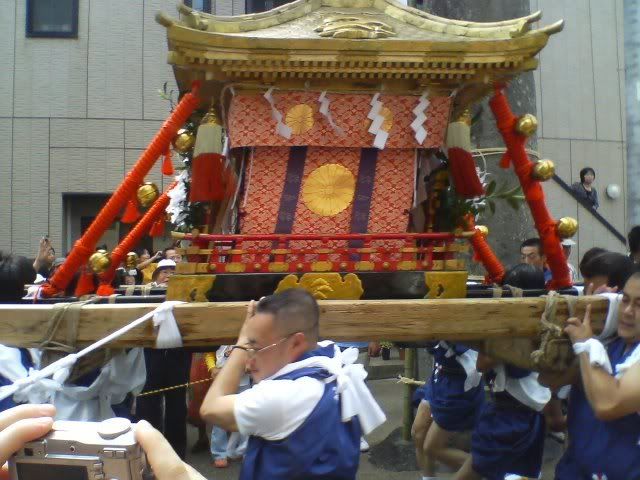 After these people were all down the steps and through the crowd, we looked back up towards the main shrine and saw the small shrines being brought down the steps. Around this time people around us started getting stirred up, and the men in blue banded together tightly. It turned out that they were there, I believe, to keep us safe, acting as a human barrier while MORE men in blue came running (yes running) down towards the street with these two huge, obviously very heavy, red shrines. As they ran
After these people were all down the steps and through the crowd, we looked back up towards the main shrine and saw the small shrines being brought down the steps. Around this time people around us started getting stirred up, and the men in blue banded together tightly. It turned out that they were there, I believe, to keep us safe, acting as a human barrier while MORE men in blue came running (yes running) down towards the street with these two huge, obviously very heavy, red shrines. As they ran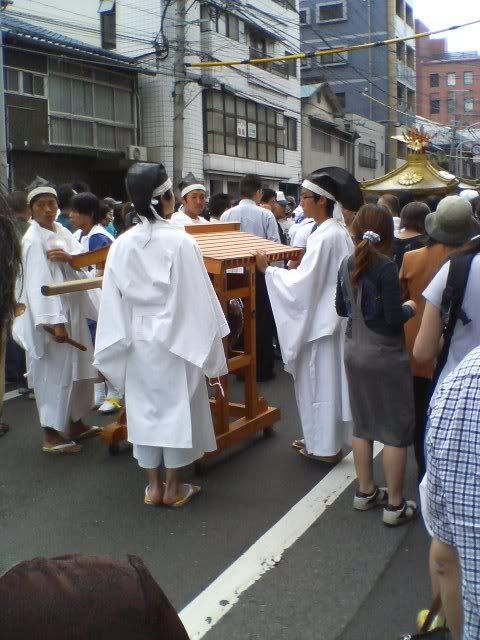 some money jumped from the shrines, and after the second one had run past us people went look for the loose change.
some money jumped from the shrines, and after the second one had run past us people went look for the loose change.Since this was apparently the main event, everybody started making their way down towards the street, and the scene there was just a huge mob of people, following this procession. The young men in white that went ahead earlier seemed to be attending to a mounted taiko drum, and I guess the procession was paused because they stood around for a convenient little while, allowing us gaijin to snap away with our cameras. *laughs*
The main crowd stared following the small shrines and people down that street, but Kondo-sensei felt it was a better idea to go down to a parallel street and just meet up with them further down. So, after a pit-stop at a conbini (convenience store) and re-fueling with lemon flavoured water (for me) and coffee (for Alex), we set down the adjacent street. After a few minutes we did indeed see the procession happening again, but with much more going on! We got to finally see something that was a hallmark of this festival - the kasaboko.
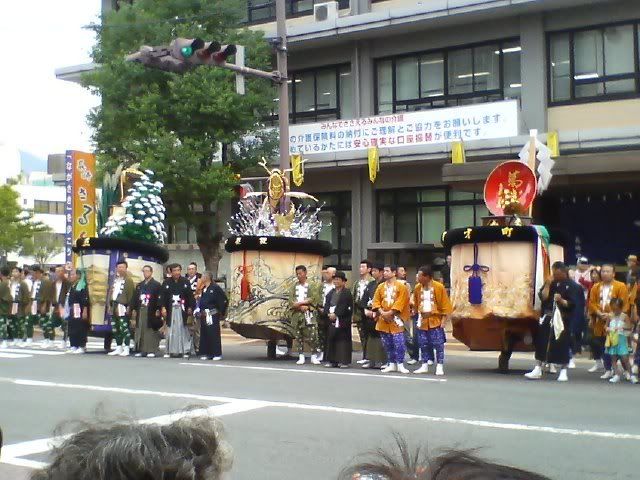 I'm going to draw an exerpt from that pamphlet again, 'cause it's handy and I'm lazy! :)
I'm going to draw an exerpt from that pamphlet again, 'cause it's handy and I'm lazy! :)"What is a kasaboko? Each odoricho's (town's) performance begins with a kasaboko: a huge, parasol-like object. The kasaboko has a placard with the town's name, decorations representing the town placed on top, and a veil draped all around the sides. Each kasaboko weighs 130-150 kg, and is carried on the shoulder of one person inside. This person can't see a
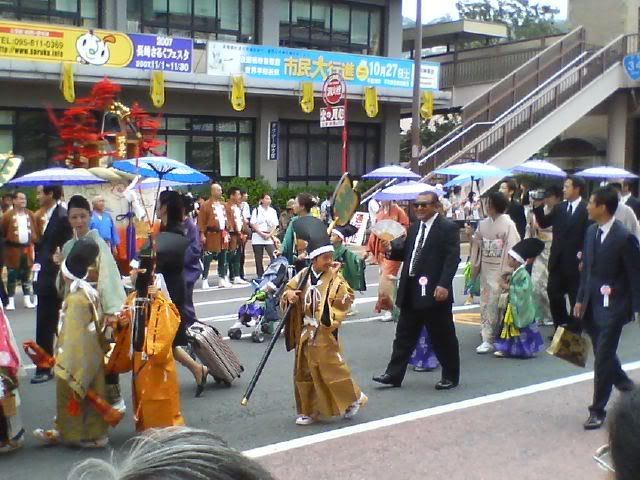 round him, so a second person, the kasaboko-toryo, guides him by using a a small flag."
round him, so a second person, the kasaboko-toryo, guides him by using a a small flag."Pretty nifty eh? The weight of those things blows me away. So, anyway, when we got there there kasaboko were all lined up along the opposite side of the street, and a procession of other people was flowing past t
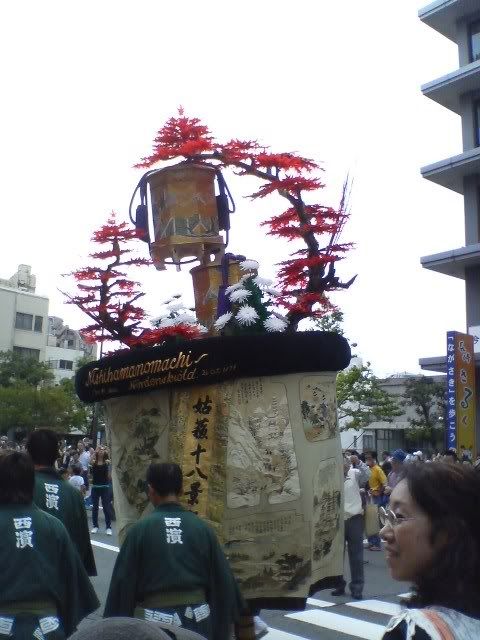 hem. I'm afraid I don't know why or who they were, but they were pretty much 80% in traditional garb, so that was pretty cool. Here are a couple of pics. Sorry for the crappy quality!
hem. I'm afraid I don't know why or who they were, but they were pretty much 80% in traditional garb, so that was pretty cool. Here are a couple of pics. Sorry for the crappy quality!After the procession was finished, the kasaboko were picked up and started to make their own way down the street. They paraded down and away from us, and that was the last I saw of them. As the snippet from the pamphlet said, on top of each kasaboko were decorations representing each town. We didn't know it then, but this golden statue was a small prelude to one of the two performances we'd get to see that day. I can't identify which floats belonged to which town other than that with the golden statue, but they did all look purdy.
Once the kasaboko and crowd had gone the other way (and we found Zhang after temporarily losing her - hate to say it, but it was like looking for a piece of hay in a haystack), Kondo-sensei reccomended we head down towards Nagsaki station. Though the Sawa Shrine was where all the performances came to a head, getting a seat there usually requires camping out ahead of time, and we obviously hadn't done that. Luckily, all of the towns also go to the station to perform, which has a square and lots of places to view it from around and above.
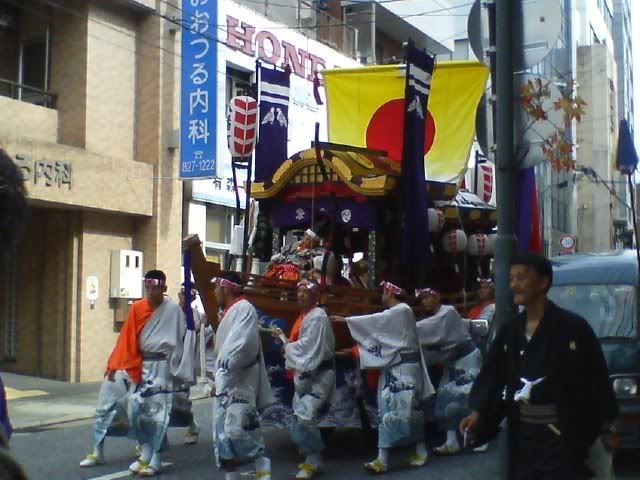
On the way there though, we heard singing and drumming, and followed the sound. It turned out to be a large boat, being pushed and pulled by a team of men, with teams of young children playing taiko drums inside. From what we could tell, they were going from business to business. Each time they stopped in front of a store-front, they turned to it, sang and shouted, and the kids drummed, then the team bowed and moved on. My guess is it's a blessing for that store owner. My favourite part of this boat though, had to be the small boy in the front who was dressed up in special-looking robes, and was completely kno
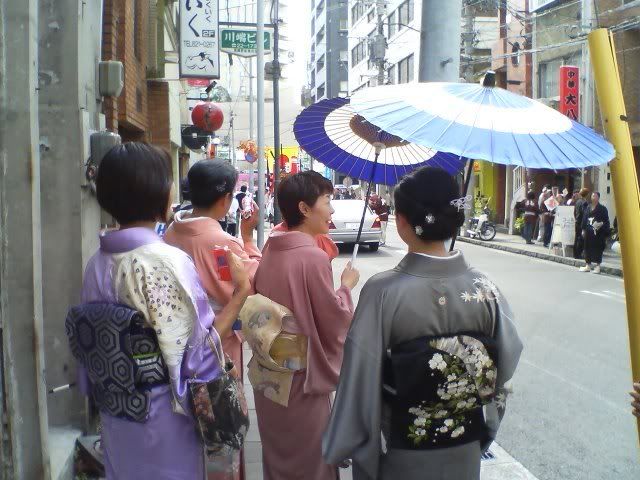 cked out. I couldn't get a great picture of him, but if you look, you can see his little sleeping form at the front.
cked out. I couldn't get a great picture of him, but if you look, you can see his little sleeping form at the front.Following the float on foot were a number of women, all dressed in stunning kimono, and again this is just a guess, but I wouldn't be surprised if they were the mothers of the children in the boat, or at least wives of the men doing this arduos journey. There was also teams of people running around making these chalk marks on the ground, I'm not sure why, but they looked kinda neat so I snapped a shot.
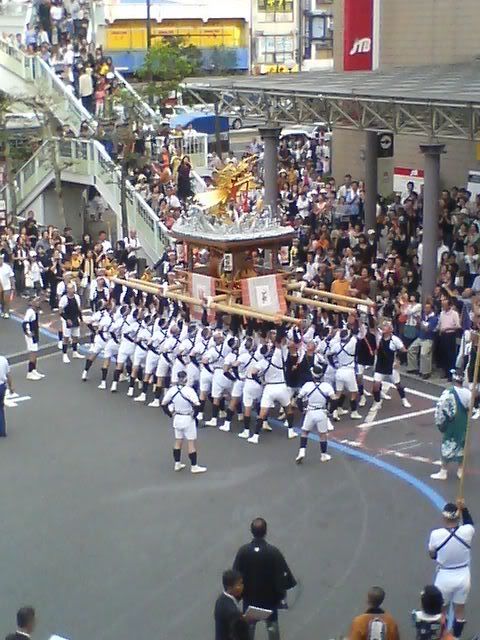
Right in front of Nagasaki station there is a network of risen walkways, as are so popular in Japan. You walk up some step and cross the street from above all the traffic. While up there we heard a new kind of music, what sounded like a chorus of men singing. Looking down we soon saw where the sound was coming from, as our first 'official' float of the Kunchi festival came into view. This group was from 'Ginya-machi', which means 'metal town'. This town is so called because it was once famous for the number of silversmiths that used to occupy it. The pamphlet says: "The town had a close relationship with the Tokugawa Shogunate who ordered many silver products." So I suppose it's no surprise that this float is carried by rows of very strong-looking men, all wearing what I would assume is traditional metalsmithing gear.
They carry the huge float own the street, singing this really lovely chorus, and occasionally they stop to lift the float up and down in their hands. Considering that it weighs a couple hundred kilograms, this is quite a feat. One move they also did was to actually throw the float up into the air, clap their hands and catch it again. When you keep in mind that inside the float are three young children playing taiko drums to go along with the chorus, every time they pulled this off a resounding 'oooohhhh' went through the crowd. After a short rest, the float proceded into a cleared-out courtyard within the station, where some taiko drums were played (and there were a couple of women players, wut!) , and the men sung, spun, and threw the float around. On top of the float was
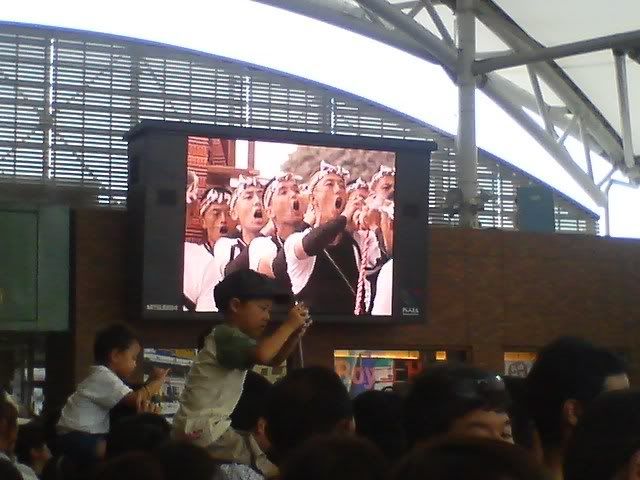 a huge golden fish, called the 'shachichoko' (ancient fish), which comes from Nagoya castle. If you remember, there was the smaller version of it on the small kasaboko seen earlier.
a huge golden fish, called the 'shachichoko' (ancient fish), which comes from Nagoya castle. If you remember, there was the smaller version of it on the small kasaboko seen earlier.The station was incredibly crowded, an every available spaced was filled with a body. We tried to see down into the court-yard from the walkways that lined the outside of the second floor, but we were forced to watch the Ginya-machi float perform from a large screen mounted across from us. Alex griped that we might as well have been at home, and he was right, but it was still cool to hear them down below us.
After the Ginya-machi men all moved on, we waited around for a little bit and another of the Okunchi performances moved into the courtyard, which was the Gotoh-machi "Jaodori", or "Dragon Dance". Chinese-inspired, the performers aim for speed and height with their dragon, which also weighs in at over 100 kgs. I didn't get any good pictures of this performance unfortunately, as we again had to watch it from the jumbo-tron and it was too far below to snag any good shots.
I found this really great site for info and pics of the whole festival though, which I encourage you guys to check out, because we really only got to see just a fraction of all that went down during the three day festival. There are some awesome pictures on there, not taken by a camera phone! :D
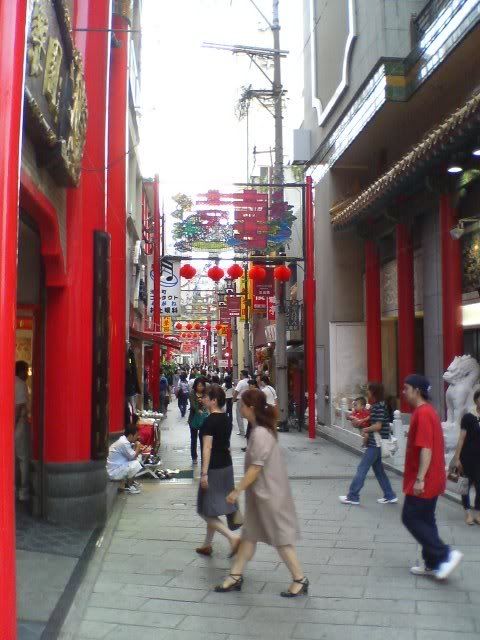
So, after we left the festival we headed down into Nagasaki's China-town, because Zhang wanted to check it out. We didn't do a whole lot there, but we did come across a pool outside a restaurant with some honkin' big koi. Being a assembly of classy individuals, we of course teased them a little. Hey, we weren't the only ones!
After China-town we lugged our tired butts through a huge line of stalls selling food and games, that was absolutely stuffed with people. At this time I can't remember why we did that. *laughs* Finally we made it back to the cars and made our way home, all very sore and tired, but having had a spiffing time!! I love that word. I love hanging out with UK alts with a sense of humour. XD
So that's the end of this update for now, hope you guys enjoyed it!! Not sure when I'll update again, but I'm going to seriously look at cameras soon, so hopefully I can start taking random shots again. I realize that I'm starting to take the every-day for granted, and while that sense of normalcy is of course important for my sanity, I don't want to let this place get 'old hat'. It's truly anything but.
Much love to all of ya reading, thanks for coming!


